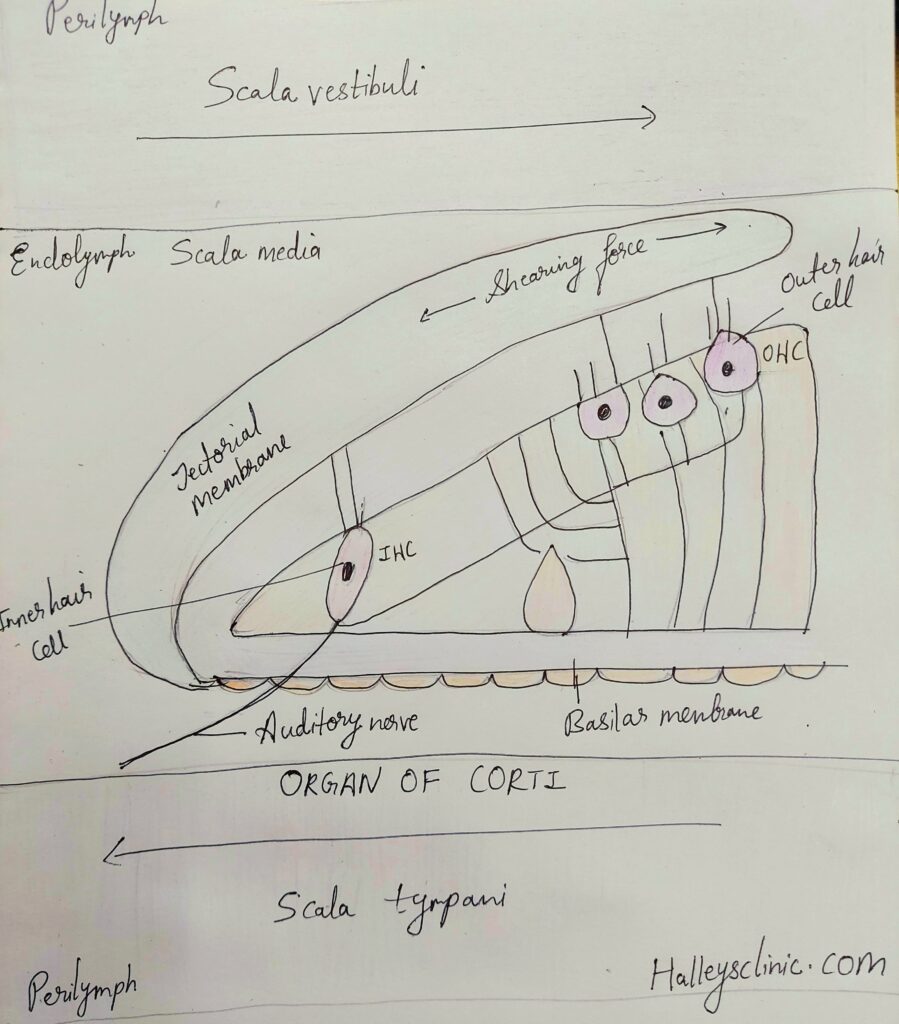HOW DO WE HEAR?

organ of corti
- BY DR. AK RANA
To hear all those melodious songs that change the vibe of the day in seconds is also one kind of magic.
Loud, fast or slow, we hear all kinds of voices right from the very beginning.
So how do we hear?
We hear by ears! Well, that’s true but not the complete one.
There is a complex mechanism that’s running behind our hearing.
Because those who don’t have ears can also hear (with the aid of implants).
PARTS OF EAR
- Pinna – The ear that we see, touch and know.
Everything else lies inside the skull (temporal bone).
- External ear- it extends up to Tympanic membrane.
- Middle ear – from tympanic membrane to round window.
It contains three small bones – malleus, incus and stapes. It’s the stapes that connects the middle ear with inner ear.
These ossicles help in amplifying the sound.
- Inner ear- It helps in both hearing and balance.
It is filled with fluid called perilymph and endolymph.
Here, lies the organ of corti.
Organ of corti is the sensory organ of hearing.
It contains inner hair cells and outer hair cells.
Inner hair cells are connected to nerve that takes impulses to the brain for interpretation.
- Tympanic membrane – It is also called ear drum. It vibrates when sound enters ear cavity.
It protects our inner ear from debris and bacteria.

MECHANISM OF HEARING
Overall hearing can be divided into two parts-
- Conduction pathway consisting of external and middle ear.
- Sensory pathway consisting of inner ear.
Sounds entering our pinna reaches tympanic membrane which vibrates.
These vibrations through middle ear and stapes enters oval window.
Through oval window they enter inner ear.
Our inner ear is divided into fluid filled compartments called scala vestibuli, scala media and scala tympani.
Organ of corti lies in scala media on Basilar membrane.
Flow is in opposite direction in scala vestibuli and tympani which stimulates organ of corti. (due to shearing force).
Basilar membrane also moves but tectorial membrane doesn’t, further adding to shearing force.
Hair cells projects to tectorial membrane, when their tips get stimulated k+ channels in tips open.
Endolymph present in scala media is rich in k+.
Potassium ions thus enter hair cells and it further leads to calcium influx.
Excitatory neurotransmitter Glutamate is released.
This impulse is taken through afferent nerve and then to cochlear nerve, rest is auditory pathway up to brain.
Various other structures are involved until we reach auditory cortex in the brain present in Superior temporal gyrus.
In this way, mechanical sound by the help of hair cells is changed into electrical impulse that our brain reads. This is how we hear.
AUDITORY PATHWAY
- Inner hair cell
- Afferent nerve
- Cochlear nerve
- Spiral ganglion
- Brain stem
- Superior olivary complex
- Lateral lemniscus
- Inferior colliculus
- Medial geniculate body
- Auditory cortex
If repeatedly or on regular basis we expose our ears to loud noises then organ of corti can gets damaged over time.
Loud noise can damage our outer hair cells.
This leads to noise induced hearing loss.
Using ear phones with high volume continuously, listening music at high volume, working at a place with continuous high noise can damage our hearing ability.
Keep a watch of no. of hours you exposed your ears to loud noise and also keep a check on it.
SHARE YOUR REVIEWS AND STORIES OR ASK QUESTONS IN THE COMMENT SECTION, OR
CONTACT OUR TEAM OF HALLEYS CLINIC halleysclinic@gmail.com
also read HOW DO WE SEE COLORS?
also read WHY DO WE FEEL HUNGRY?







